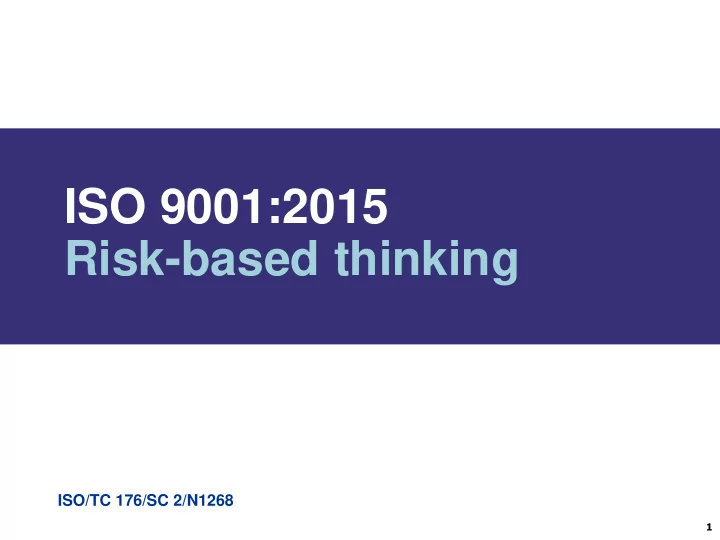

ISO 9001:2015 Risk-based thinking ISO/TC 176/SC 2/N1268 1
Purpose of this presentation To explain the concept of risk-based thinking in ISO 9001:2015 ISO/TC 176/SC 2/N1268 2
This presentation Developed by the ISO subcommittee responsible for communication about ISO 9001 Available for unrestricted public use ISO/TC 176/SC 2/N1268 3
What is risk-based thinking? Risk-based thinking is something we all do automatically and often sub-consciously to get the best result The concept of risk has always been implicit in ISO 9001 – this edition makes it more explicit and builds it into the whole management system Risk-based thinking ensures risk is considered ISO/TC 176/SC 2/N1268 from the beginning and throughout Risk-based thinking makes preventive action part of strategic and operational planning 4
Where is risk addressed in ISO 9001:2015? ISO/TC 176/SC 2/N1268 5
Risk-based thinking is in: Introduction - the concept of risk-based thinking is explained Clause 4 - organization is required to address the risks and opportunities associated with its QMS processes Clause 5 – top management is required to ̶ Promote awareness of risk-based thinking ̶ Determine and address risks and opportunities that ISO/TC 176/SC 2/N1268 can affect product /service conformity Clause 6 - organization is required to identify risks and opportunities related to QMS performance and take appropriate actions to address them 6
Risk-based thinking is in: Clause 7 – organization is required to determine and provide necessary resources Clause 8 - organization is required to manage its operational processes Clause 9 - organization is required to analyse and evaluate effectiveness of actions taken to address risks and opportunities ISO/TC 176/SC 2/N1268 Clause 10 - organization is required to correct, prevent or reduce undesired effects and improve the QMS and update risks and opportunities Note, risk is implicit whenever suitable or appropriate is mentioned (clause 7 and 8) 7
Why use risk-based thinking? Successful organizations intuitively take a risk- based approach because it brings benefits that: improve governance establish a proactive culture of improvement assist with compliance ISO/TC 176/SC 2/N1268 assure consistency of quality of goods and services improve customer confidence and satisfaction 8
How do I do it? Identify what your risks are – it depends on context Use risk-based thinking to prioritize the way you manage your processes ISO 9001:2015 does not require formal risk assessments ISO/TC 176/SC 2/N1268 ISO 31000 Risk management — Principles and guidelines may be a useful reference for organizations that want or need a more formal approach to risk (but its use is not obligatory) 9
How do I do it? Balance risks and opportunities Analyse and prioritize your risks what is acceptable? what is unacceptable? Plan actions to address the risks how can I avoid, eliminate or mitigate risks? ISO/TC 176/SC 2/N1268 Implement the plan; take action Check the effectiveness of the action; does it work? Learn from experience; improve 10
Conclusions Risk-based thinking: is not new is something you probably do already is ongoing ensures greater knowledge of risks and improves preparedness ISO/TC 176/SC 2/N1268 increases the probability of reaching objectives reduces the probability of negative results makes prevention a habit 11
Recommend
More recommend